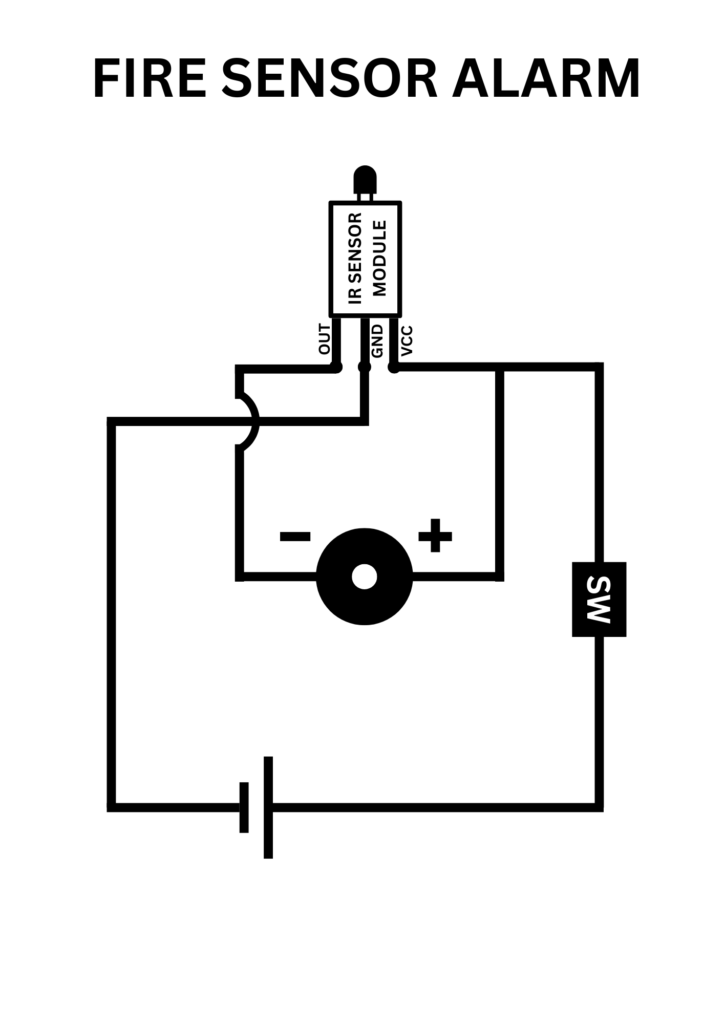Fire Sensor Alarm Investigatory Project PDF Class 12
PDF Download Link Given Below
To Get the Link Scroll Down to end of this Page
INTRODUCTION
Fire accidents are among the most dangerous disasters that can cause loss of life, property damage, and environmental destruction. One of the most effective ways to mitigate fire hazards is through early detection and rapid response. Fire sensor alarms play a crucial role in detecting the presence of fire at an early stage and alerting people to take immediate action.
This project focuses on developing a simple fire sensor alarm that can detect fire using an infrared (IR) sensor module. When a fire occurs, it emits infrared radiation, which is invisible to the human eye but can be detected using an IR sensor. Upon detecting a flame, the sensor triggers a buzzer to produce an alarm sound, warning individuals of the potential danger.
The system operates on a basic circuit comprising an IR sensor module, a buzzer, a switch, and a battery. This project demonstrates how basic electronic components can be used to create a fire detection system, making it an educational and practical approach for understanding fire safety technology. Such systems are widely used in homes, offices, and industrial settings to enhance safety and prevent fire-related disasters.
AIM
To design and construct a Simple Fire Sensor Alarm using an Infrared Sensor Module, Battery and Buzzer.
APPARATUS
- Cardboard
- Battery
- Battery Clip
- Buzzer
- IR Sensor Module
- Switch
THEORY
The working principle of the fire sensor alarm is based on the detection of infrared radiation emitted by flames. The infrared sensor module used in this project consists of an IR receiver (photodiode). The IR receiver is designed to detect infrared radiation directly from external sources, such as fire or flames. When a fire occurs, it emits infrared radiation due to the heat and combustion process. The IR receiver detects this radiation and generates an electrical signal.
The IR sensor module operates by comparing the intensity of the received infrared radiation to a predefined threshold level. If the received radiation exceeds this threshold, the sensor sends an output signal, indicating the presence of fire. This output signal is then transmitted to the buzzer, which converts electrical energy into sound energy. When the sensor detects fire, the output pin sends a voltage signal to the buzzer, activating it and producing an audible alarm to alert nearby individuals of the potential danger.
The entire circuit is powered by a 9V battery, and a switch is incorporated to control the power supply. When the switch is turned on, the IR sensor module begins monitoring the surroundings for fire presence. If no fire is detected, the circuit remains idle, ensuring energy efficiency. This simple yet effective mechanism ensures that fire detection is immediate, allowing necessary actions to be taken to prevent further hazards. The use of an IR receiver-based sensor module makes this model highly responsive and effective in detecting fire in real time.
APPLICATION
- Home Safety: Fire sensor alarms are widely used in homes to detect fire hazards early and alert residents, reducing the risk of property damage and loss of life.
- Industrial Protection: Factories and warehouses install fire alarms to prevent fire accidents, ensuring worker safety and protecting machinery and stored goods.
- Commercial Buildings: Offices, malls, and shopping complexes use fire sensor alarms to comply with safety regulations and provide an early warning system for fire outbreaks.
- Hospitals and Schools: Fire alarms are essential in hospitals and educational institutions to ensure the safety of patients, students, and staff in case of a fire emergency.
- Hotels and Restaurants: Fire detection systems in hotels and restaurants help prevent fire-related accidents caused by kitchen appliances, electrical faults, or human negligence.
- Data Centers and Server Rooms: Fire detection systems in data centers prevent critical data loss and damage to expensive computer hardware.
- Military and Defence Applications: Fire detection systems in military bunkers, ammunition storage, and defence installations prevent fire-related disasters.
CIRCUIT DIAGRAM

CONSTRUCTION
- Take a piece of cardboard measuring about 15cm by 20cm.
- Draw the given circuit diagram on the cardboard.
- Now fit all the components on the cardboard according to the circuit diagram.
- Connect the positive terminal of the 9V battery to the VCC pin of the IR sensor module.
- Connect the negative terminal of the battery to the GND pin of the IR sensor module.
- Connect the output pin of the IR sensor module to the negative terminal of the buzzer.
- Connect the positive terminal of the buzzer to the positive terminal of the battery.
- Attach a switch between the battery and the circuit to control the power supply.
- Turn on the switch and bring a small flame (e.g., a candle) near the sensor to test the response.
WORKING
When the circuit is powered on using the switch, the IR sensor module starts scanning its surroundings for infrared radiation emitted by a fire source. If no fire is present, the sensor remains inactive, and the buzzer does not produce any sound. However, when a fire is introduced near the sensor, the IR receiver detects the emitted infrared radiation. This triggers the sensor module to send an output signal to the buzzer. Upon receiving this signal, the buzzer gets activated and produces a loud alarm sound, alerting individuals about the presence of fire. Once the fire is removed, the infrared radiation is no longer detected, and the sensor stops sending an output signal. Consequently, the buzzer turns off, and the system returns to its standby mode, ready to detect fire again when necessary. This simple mechanism allows for real-time fire detection and alerting, making it a useful safety device.
OBSERVATION
- The buzzer activates when a flame is placed near the sensor, confirming the proper working of the fire detection system.
- The response time of the sensor is quick, allowing for rapid detection of fire.
- The sensitivity of the sensor depends on the intensity of the flame and its distance from the sensor.
- The circuit remains idle when no flame is present, ensuring efficient power consumption.
CONCLUSION
The fire sensor alarm successfully detects the presence of fire using an infrared sensor and alerts people through an audible buzzer. This project effectively demonstrates the working principle of fire detection systems, highlighting their importance in safety applications. The simplicity of the circuit makes it an ideal educational model to understand the role of infrared sensors in fire safety. Additionally, this project showcases how electronic components can be used to create practical safety devices that can help prevent fire-related disasters. This model can be further improved by incorporating additional safety features such as automatic water sprinklers or remote alarms for enhanced fire prevention.
PRECAUTIONS
- Ensure proper connections to avoid short circuits.
- Do not expose the battery to high temperatures.
- Test the model in a controlled environment to prevent fire hazards.
- Avoid placing the fire sensor alarm near highly flammable materials during testing.
- Keep water or a fire extinguisher nearby while testing the device as a safety precaution.
- Do not use an excessively large flame near the sensor, as it may damage the IR receiver.
- Check the connections carefully before powering the circuit to avoid wiring errors.
- Switch off the circuit when not in use to prevent the battery from discharging.

